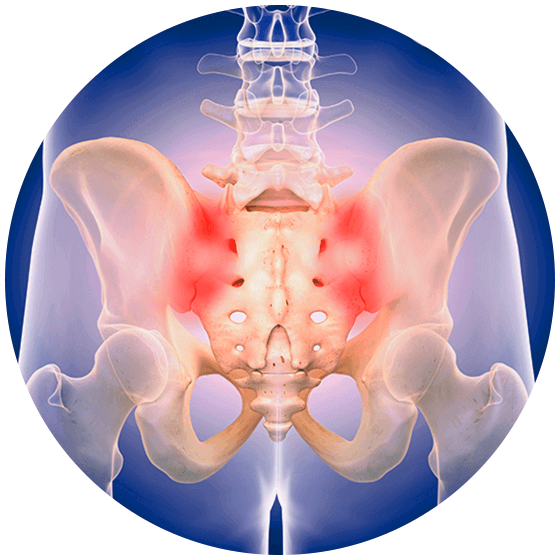Sacroiliac Joint Pain

Sacroiliac Joint Pain Symptoms & Treatment Options
The sacroiliac joint (SI joint) is a major juncture in the body at which the spine attaches to the hips. It is composed of two major structures: the sacrum and the iliac bones. Consisting of 5 fused vertebrae, the sacrum is located between the lumbar spine and the tailbone. This semi-rigid section of our spine joins to the interior of the ilium bones. The ilia are the two bones that we often associate with our hips, fanning out on either side. To locate this joint in your body, look for two dimples on your lower back. These indentations lie on top of the SI joints.
Moreover, the joint between the sacrum and ilium is a unique structure. It has an individualized size and shape much like our fingerprints. Like the pieces of a puzzle, the sacroiliac bones are designed to fit seamlessly together along a series of ridges and bumps. The linking bones are cushioned in-between by two layers of protective cartilage. Adjacent nerves monitor and send messages to the brain and nearby ligaments serve to reinforce the joint itself.
What is Sacroiliac Joint Pain?
Because the sacroiliac joint is one of the main connections between the upper and lower body, it plays an integral role in our stability. The SI joint acts chiefly as a shock absorber, dampening forces between the upper body and the legs and enabling us to maintain our steadiness. Jumping, bouncing in a car, carrying heavy objects—these everyday impacts are all buffered with the help of the SI joint.
Although the SI Joint is mainly static, certain spinal conditions, trauma, or degenerative disorders can cause the SI joint to shift out of position. When the joint becomes unaligned or the tissues that support the SI bones become injured or compromised by illness, these bones can rub together and pinch the nerves that pass in-between them. This condition is what we refer to as Sacroiliac Joint Pain or Sacroiliac Joint Dysfunction. Resulting from conditions such as osteoarthritis, rheumatoid arthritis, sports injuries, falls, accidents, or hormonal changes during pregnancy, SI Joint Dysfunction can generate a slew of debilitating symptoms.
If you or someone you know is experiencing sacroiliac joint pain, the following symptoms may emerge:
Localized pain experienced in the lower back, buttocks, or hips
Radiating pain, typically along the front or back side of one leg
Stiffness or a feeling of immobility in the lower back region
Tingling sensations in the lower back, buttocks, or hips
Pain linked to specific movements, such as rolling over in bed
A feeling that your legs may buckle or give out under you, resulting in falls
Symptoms of Sacroiliac Joint Pain
Symptoms of sacroiliac joint pain can vary depending upon the person and the cause of the inflammation. It is important to keep in mind that the symptoms associated with SI joint pain can be very similar to those of other spinal and skeletal conditions, such as bulging or herniated discs and sciatica. It is important to work with a physician to receive an accurate diagnosis.
Our team of knowledgeable physicians at the Advanced Spine Center will work one-on-one with you to establish an individualized plan of action to extinguish your pain. Experienced in state-of-the-art and minimally invasive treatments, our team of orthopedic surgeons ranks among the Top Doctors in New Jersey for superior, patient-centered, and compassionate care.
Determining a Diagnosis of Sacroiliac Joint Pain
Nestled deeply within the body, the sacroiliac joints can pose difficulty for examining. Additionally, the symptoms of SI joint pain can be very similar to other spinal conditions. Keep in mind, however, that doctors can trace a significant number of reported back pain cases back to SI joint pain. Therefore, it is important to work closely with your physician to reach an accurate diagnosis.
There are many techniques that your physician may employ to determine if you are suffering from sacroiliac joint pain or to rule out other possible conditions. To begin, physical examinations and an evaluation of your family medical history will most likely occur. Next steps may include the use of X-rays, MRIs, or CT scans. Unfortunately, the SI joints are sometimes difficult to pick up on scans due to their depth in the body. Your medical provider may need to perform additional diagnostic tests.
Two of the main detection techniques to diagnose SI joint dysfunction include movement analysis and injections. Your physician may ask you to complete a number of gentle movements which will target the joint and enable a more thorough evaluation of your condition. Furthermore, injections called sacroiliac joint blocks or diagnostic SI injections can be used to determine the location of inflammation. During this procedure, your physician will use X-ray imaging to inject a corticosteroid into the body at the sacroiliac joint. If these injections ease your discomfort, you can infer that the sacroiliac joint is the source of your pain.